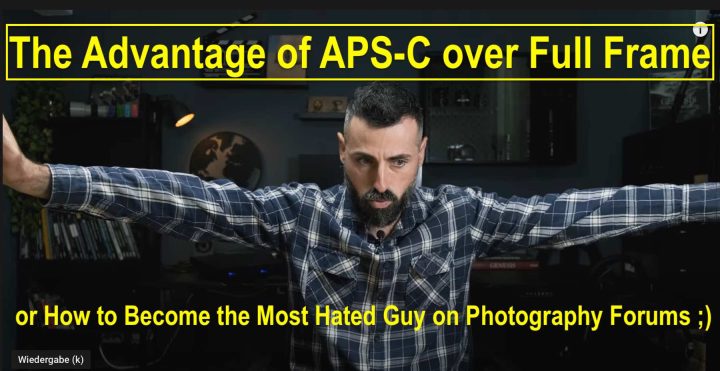The Advantage of APS-C over Full Frame… or How to Instantly Become the Most Hated Guy on Photography Forums ;)

Italian professional photographer Andrea Jump Cimini is a man on a mission: become the most hated guy on photography forums ;).
So how is he going to achieve that?
Well, by telling you which advantages APS-C has over Full Frame especially for event photography in low light.
With 2,700 subscribers only (but quickly and well deserved growing), Sony and Canon probably still did not fly that guy around at fancy and fun events nor spoil him by giving him pre-production gear to test. So, out of the control of big corporation he speaks something rare to find these days: his honest and un-biased opinion ;).
The video is Italian, so if you understand Italian, watch the video below. If not, we have a summary for you guys.
- Thanks to Canon and Nikon, we grew up with the idea that APS-C is mostly a less professional system, that serves mostly just a transition system to then arrive at Full Frame, where the real photographers are, people full of creamy background with rainbows and mini-ponies
- This image of APS-C has a bit changed over time, especially thanks to Fujifilm, who built up a strong APS-C system also with professional cameras and lenses
- for many the only real advantage of APS-C are size and price
- but APS-C has also advantages like a faster sensor readout, which means less rolling shutter (in video or stills with electronic shutter) and faster bursts
- some will ask why then Nikon, Canon and Sony don’t push their APS-C systems. The reason is marketing. Their FF systems are accepted by everybody and sell good so why create internal competition? Plus they’d now have to fight against Fujifilm, who in APS-C is already dominant
- but the real advantage is depth of field
- if you have a f/1.4 full frame lens, it’s not that you will use it at f/1.4 all the time, just like if you own a Ferrari you don’t drive it all the time at 174 miles per hour (280 km/h) speed all the time just because it can drive so fast
- the reason why camera companies started to make always faster lenses was not to offer always shallower DOF
- remember the legendary Zeiss Planar 50mm f/0.7. It was developed for the NASA to take images in space (hence very low light) using a bit faster shutter speeds, so images don’t have too much motion blur
- the Zeiss Planar 50mm f/1.7 then became mega-famous because Stanley Kubrik used it in his movie “Barry Lyndon” to film a scene with only candle light [easily the movie with the best photography in any movie ever made on planet earth. If you haven’t yet, it’s included in Amazon Prime Video]
- so the reason why camera manufacturer made faster and faster lenses was not to offer always shallower DOF. Even with autofocus today, it is not very easy to nail the focus at f/1.2 full frame DOF
- also, the super shallow DOF that is en vogue now in photography, you rarely find it in movies, because directors want to tell stories, and in order to do that they need details and context
- it’s about giving our subjects a context using details that are in the background, and that’s fundamental if you want to tell stories with your images
- and here is the big advantage of APS-C: in an image with the same depth of field, an APS-C camera creates a file that has about 1 stop more light than a Full Frame camera
- a practical example:
– let’s take the Fujinon XF50mmF1.0 and any Full Frame 75mm f/1.4
– it is true that the XF50mmF1.0 will create an image that is equivalent to 75mm on Full Frame
– it is true that the XF50mmF1.0 at f/1.0 will create an image that gives you about the same shallow depth of field of an f/1.4 on full frame
– but the XF50mmF1.0 is an f/1 lens compared to an f/1.4 lens, so it will have about 1 stop more of light - an on field example:
– imagine you have to photography a group of 2/3 people in low light (at a wedding, an event, etc)
– with a full frame camera, in order to have all faces in focus, he would have to stop down at f/4 (unless he would place all people at exactly the same distance, but sadly people have that bad habit to move)
– stopping down at f/4 means he would have to raise ISO, which creates more noise and effects negatively dynamic range
– but with a Fujinon lens you’d just have to stop down at f/2 or f/2.5 to have the same depth of field, and hence you have about 1 stop more of light at the same depth of field
– the file would be cleaner and have more dynamic range
– [admin note: as we have reported here, you’d also be allowed to shoot at faster shutter speeds, hence reducing motion blur, which is one of the advantages of APS-C] - he then goes on comparing prices of APS-C and FF lenses and shows how much more affordable Fujinon lenses are
Food for thoughts ;)
And since we talked about Barry Lyndon, if you understand Italian, check out Marco Fazio’s video about it.

